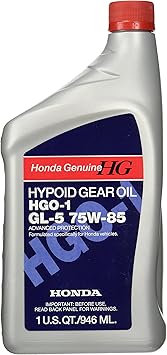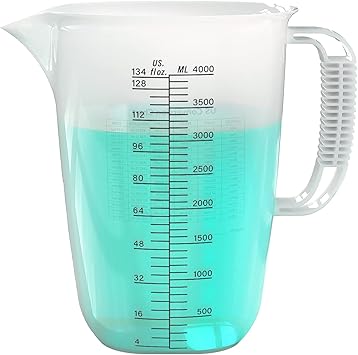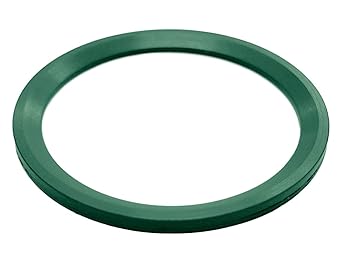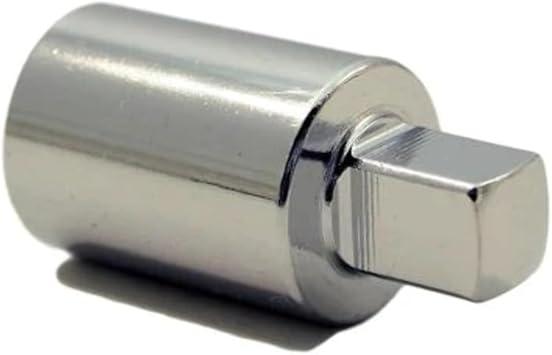I wouldn't say that I tow regularly, but I do tow my boxy travel trailer periodically. At about 40,000 miles on the clock, I'm halfway to Honda's recommended transmission and transfer case fluid change and I figured that it's now or never, so I decided to just go ahead and pull the trigger.
To prepare, I bought:
4 quarts of Honda Type 3.1 ATF 08200-9017 for $123.50 ($30.88 each!):
1 quart of Honda HGO-1 Gl-5 75W-85 Hypoid Gear Oil 08200-9014 for $26.08:

This 500cc oil pump for $12:
This 1-gallon graduated measuring pitcher for $23:

I also picked up this long funnel from Walmart:
![Image]()
I decided to take a 2-pronged approach and use both weight and volume to determine how much fluid to replace, just for a nice gut-check that I'm not messing something up too horribly wrong.
First, using the pair of central jack points and a floor jack, I lifted both ends of the Ridgeline up and supported them with 4 jack stands.
Next, get the kitchen scale and weigh the empty 1-gallon pitcher at 11.7oz:
![Image]()
Using a couple long extensions, an 8mm socket, and a section of 8mm Allen wrench from another project, I cracked the fill port open from the top side. Then from below, I cracked the drain port loose. I was able to hold the empty 1-gallon pitcher up directly under the drain hole as I unthreaded the drain plug by hand. Once the fluid was flowing, I just set the pitcher on the floor and let it drain out for a while.
![Image]()
According to the 1-gallon pitcher, I got juuuuust over 124 fluid ounces of volume of fluid out:
![Image]()
According to the kitchen scale, I got 109.40 oz of fluid out by weight (121.10oz - 11.7oz empty pitcher weight):
![Image]()
The ZF 9-Speed drain and fill plugs have integrated gaskets. I realize that you're supposed to replace them at each fluid change, but I didn't see that as necessary.
![Image]()
![Image]()
Interestingly, the sealing washer on the lip of the plugs has a DIN number:
![Image]()
"DIN 3869-18-FKM-dt"
DIN 3869 is a standard D-shaped washer. FKM is the material (Viton). 18 may indicate a size 18 washer. I wish now that I'd have grabbed my dial calipers and measured the washer for confirmation but this may be the exact washer at $13 for a 10-pack:
 Otherwise if it's a size not available on Amazon, there are lots of standard sizes of this washer available for about 45 cents each, plus about $7 shipping.
Otherwise if it's a size not available on Amazon, there are lots of standard sizes of this washer available for about 45 cents each, plus about $7 shipping.
 www.oringsandmore.com
www.oringsandmore.com
Anyway, considering they want like $30 for one drain plug, just replacing the rubber washer on an otherwise fine plug seems like a very economical solution.
I weighed each new bottle of transmission fluid and poured 3 of them in, shaking them well first. Nice and green:
![Image]()
Each bottle weighed 30.35 ounces when full and varied very slightly when empty, meaning that 3 bottles added up to 84.45 ounces, meaning that I needed to add 24.95 ounces (109.4 - 84.45) from the last bottle. That bottle started at 30.35 ounces, so it needed to weigh 5.40 ounces when done.
![Image]()
As a side note, if that last bottle weighs 2.2 ounces empty, then that should leave 3.2 ounces (5.4 - 2.2) in the bottle. I found that each bottle contained about 28.15 ounces of fluid by weight. So if 28.15 ounces = 946ml (as printed on each bottle), then 3.2 ounces = 107.5 ml remaining in that last bottle. Looking at the sight scale on the side of the bottle, I'd say this checks out very well! The fluid line is just above 100ml.
Also, as another gut check, 107.5 ml / 946 ml = 11.37% of that quart bottle remaining. So by volume, the first 3 bottles are 32 fluid ounces and the last bottle is 28.36 fluid ounces (0.8863 * 32). That's 3 * 32 + 28.36 = 124.36 fluid ounces. I'd say that's exactly what the 1-gallon pitcher showed on its scale. Ok, I'm confident that weighing the ATF using the kitchen scale produced accurate results!
Then I moved on to change the transfer case fluid, which was fairly straightforward. I had two issues...
Issue 1:
My brand new 10mm square drain plug tool is the wrong size. I bought this tool:
 I had read that the fill and drain plugs are NOT 3/8" square, but actually 10mm square. People had posted that a 3/8 drive will fit into the plug but it'll be a little loose and could increase the risk of stripping out the plug. So I bought the 10mm adapter. Well, in my case the adapter doesn't fit at all and a 3/8 extension fits perfectly in the square drain plug hole. So I don't know if Honda changed plugs somewhere along the line or if the rear diff is 10mm or what. But anyhow, I ended up just using a short socket extension on the transfer case which worked great. The plugs were pretty tight, but I had a 3/8" to 1/2" adapter on a long 1/2" ratchet which broke them loose pretty easily. I did not bother to replace the crush washers and instead just cleaned them and put them back together again.
I had read that the fill and drain plugs are NOT 3/8" square, but actually 10mm square. People had posted that a 3/8 drive will fit into the plug but it'll be a little loose and could increase the risk of stripping out the plug. So I bought the 10mm adapter. Well, in my case the adapter doesn't fit at all and a 3/8 extension fits perfectly in the square drain plug hole. So I don't know if Honda changed plugs somewhere along the line or if the rear diff is 10mm or what. But anyhow, I ended up just using a short socket extension on the transfer case which worked great. The plugs were pretty tight, but I had a 3/8" to 1/2" adapter on a long 1/2" ratchet which broke them loose pretty easily. I did not bother to replace the crush washers and instead just cleaned them and put them back together again.
Issue 2:
Because I bought the Honda fluid, the bottle had a mouth that was WAY too big to fit into the fill hole. Fortunately I had the fluid transfer pump thing noted above. I was able to suck over half of the quart bottle up into the pump and push it straight into the transfer case very easily. Then I squirted the remainder back into the bottle for use next time. @zroger73 gave the great advice to use a small pump sprayer instead, which I think is also a great idea! Just cut the tip of the wand off and shoot the fluid right in the hole.
After I got everything buttoned back up again, I then took the Ridgeline down off the jack stands and took it for a spin and noticed no difference in performance. I call that a win. Hopefully this helps someone else looking to save some cash by changing their own transmission and transfer case fluid.
To prepare, I bought:
4 quarts of Honda Type 3.1 ATF 08200-9017 for $123.50 ($30.88 each!):
1 quart of Honda HGO-1 Gl-5 75W-85 Hypoid Gear Oil 08200-9014 for $26.08:

Amazon.com: Genuine Honda 08200-9014 Hypoid Gear Oil Hgo-1 Gl-5 75W-85 : Automotive
Buy Genuine Honda 08200-9014 Hypoid Gear Oil Hgo-1 Gl-5 75W-85: Gear Oils - Amazon.com ✓ FREE DELIVERY possible on eligible purchases
www.amazon.com
This 500cc oil pump for $12:
This 1-gallon graduated measuring pitcher for $23:

Amazon.com: Luvan 1 Gallon Measuring Pitcher, Large Measuring Cup with Spout and Handle, 134oz Plastic measuring pitcher with Conversion Chart, 1 Gallon Measuring Container for Motor Oil, Chemicals, Pools, Lawns: Home & Kitchen
Online Shopping for Kitchen Utensils & Gadgets from a great selection at everyday low prices. Free 2-day Shipping with Amazon Prime.
www.amazon.com
I also picked up this long funnel from Walmart:
I decided to take a 2-pronged approach and use both weight and volume to determine how much fluid to replace, just for a nice gut-check that I'm not messing something up too horribly wrong.
First, using the pair of central jack points and a floor jack, I lifted both ends of the Ridgeline up and supported them with 4 jack stands.
Next, get the kitchen scale and weigh the empty 1-gallon pitcher at 11.7oz:
Using a couple long extensions, an 8mm socket, and a section of 8mm Allen wrench from another project, I cracked the fill port open from the top side. Then from below, I cracked the drain port loose. I was able to hold the empty 1-gallon pitcher up directly under the drain hole as I unthreaded the drain plug by hand. Once the fluid was flowing, I just set the pitcher on the floor and let it drain out for a while.
According to the 1-gallon pitcher, I got juuuuust over 124 fluid ounces of volume of fluid out:
According to the kitchen scale, I got 109.40 oz of fluid out by weight (121.10oz - 11.7oz empty pitcher weight):
The ZF 9-Speed drain and fill plugs have integrated gaskets. I realize that you're supposed to replace them at each fluid change, but I didn't see that as necessary.
Interestingly, the sealing washer on the lip of the plugs has a DIN number:
"DIN 3869-18-FKM-dt"
DIN 3869 is a standard D-shaped washer. FKM is the material (Viton). 18 may indicate a size 18 washer. I wish now that I'd have grabbed my dial calipers and measured the washer for confirmation but this may be the exact washer at $13 for a 10-pack:

Amazon.com: #8 DIN 3869 Profile Ring, Viton (FKM) 80 Duro Green (Pack of 10) : Sports & Outdoors
Buy #8 DIN 3869 Profile Ring, Viton (FKM) 80 Duro Green (Pack of 10): Optics Rings - Amazon.com ✓ FREE DELIVERY possible on eligible purchases
www.amazon.com
Metric FKM Din 3869 D Rings - OringsandMore
Anyway, considering they want like $30 for one drain plug, just replacing the rubber washer on an otherwise fine plug seems like a very economical solution.
I weighed each new bottle of transmission fluid and poured 3 of them in, shaking them well first. Nice and green:
Each bottle weighed 30.35 ounces when full and varied very slightly when empty, meaning that 3 bottles added up to 84.45 ounces, meaning that I needed to add 24.95 ounces (109.4 - 84.45) from the last bottle. That bottle started at 30.35 ounces, so it needed to weigh 5.40 ounces when done.
As a side note, if that last bottle weighs 2.2 ounces empty, then that should leave 3.2 ounces (5.4 - 2.2) in the bottle. I found that each bottle contained about 28.15 ounces of fluid by weight. So if 28.15 ounces = 946ml (as printed on each bottle), then 3.2 ounces = 107.5 ml remaining in that last bottle. Looking at the sight scale on the side of the bottle, I'd say this checks out very well! The fluid line is just above 100ml.
Also, as another gut check, 107.5 ml / 946 ml = 11.37% of that quart bottle remaining. So by volume, the first 3 bottles are 32 fluid ounces and the last bottle is 28.36 fluid ounces (0.8863 * 32). That's 3 * 32 + 28.36 = 124.36 fluid ounces. I'd say that's exactly what the 1-gallon pitcher showed on its scale. Ok, I'm confident that weighing the ATF using the kitchen scale produced accurate results!
Then I moved on to change the transfer case fluid, which was fairly straightforward. I had two issues...
Issue 1:
My brand new 10mm square drain plug tool is the wrong size. I bought this tool:

Amazon.com: CTA Tools 2037 Square Head Drain Plug Socket - 10-Millimeter
Amazon.com: CTA Tools 2037 Square Head Drain Plug Socket - 10-Millimeter
www.amazon.com
Issue 2:
Because I bought the Honda fluid, the bottle had a mouth that was WAY too big to fit into the fill hole. Fortunately I had the fluid transfer pump thing noted above. I was able to suck over half of the quart bottle up into the pump and push it straight into the transfer case very easily. Then I squirted the remainder back into the bottle for use next time. @zroger73 gave the great advice to use a small pump sprayer instead, which I think is also a great idea! Just cut the tip of the wand off and shoot the fluid right in the hole.
After I got everything buttoned back up again, I then took the Ridgeline down off the jack stands and took it for a spin and noticed no difference in performance. I call that a win. Hopefully this helps someone else looking to save some cash by changing their own transmission and transfer case fluid.





